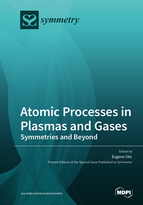Atomic Processes in Plasmas and Gases: Symmetries and Beyond
A special issue of Symmetry (ISSN 2073-8994). This special issue belongs to the section "Physics".
Deadline for manuscript submissions: closed (30 April 2021) | Viewed by 14758
Special Issue Editor
Interests: atomic, molecular and optical physics; laser physics; plasma physics; astrophysics; nonlinear dynamics; fundamentals of quantum mechanics
Special Issues, Collections and Topics in MDPI journals
Special Issue Information
Dear colleagues,
Atomic processes in plasmas and gases encompass broad areas in theoretical and experimental atomic and molecular physics. One example is atomic processes that are involved in the study of various types of plasmas over a wide range of electron densities (from 1011 to 1023 cm-3) and temperatures (from eV to a few keVs). Topics in this area include (but are not limited to) magnetic-fusion plasmas, laser-produced plasmas, relativistic laser–plasma interactions, powerful radiation sources (Z-pinches, plasma focus, XFEL, etc.), low-temperature and industrial plasmas, astrophysical plasmas, and plasma spectroscopy for all of the above applications. Another example is atomic and molecular processes in neutral gases. Topics in this area include (but are not limited to) molecular spectroscopy of gases, from low to ultrahigh resolution, from microwaves to ultraviolet, and from fundamental science to applications such as astronomy and atmospheric science.
Considerations of symmetry often play an important role in theoretical advances, especially in plasma spectroscopy and molecular spectroscopy. For example, the employment of additional conserved quantities originating from algebraic symmetries of underlying quantum systems frequently allows obtaining important analytical results and/or leads to more robust codes.
This Special Issue welcomes presentations of new theoretical and experimental results on atomic processes in plasmas and gases (with or without the use of symmetries). This Special Issue also welcomes presentations of reviews (full-size or mini reviews) on any subfield of this broad research area.
Prof. Dr. Eugene Oks
Guest Editor
Manuscript Submission Information
Manuscripts should be submitted online at www.mdpi.com by registering and logging in to this website. Once you are registered, click here to go to the submission form. Manuscripts can be submitted until the deadline. All submissions that pass pre-check are peer-reviewed. Accepted papers will be published continuously in the journal (as soon as accepted) and will be listed together on the special issue website. Research articles, review articles as well as short communications are invited. For planned papers, a title and short abstract (about 100 words) can be sent to the Editorial Office for announcement on this website.
Submitted manuscripts should not have been published previously, nor be under consideration for publication elsewhere (except conference proceedings papers). All manuscripts are thoroughly refereed through a single-blind peer-review process. A guide for authors and other relevant information for submission of manuscripts is available on the Instructions for Authors page. Symmetry is an international peer-reviewed open access monthly journal published by MDPI.
Please visit the Instructions for Authors page before submitting a manuscript. The Article Processing Charge (APC) for publication in this open access journal is 2400 CHF (Swiss Francs). Submitted papers should be well formatted and use good English. Authors may use MDPI's English editing service prior to publication or during author revisions.
Keywords
- atomic and molecular processes
- plasma spectroscopy
- astrophysical plasmas
- magnetic-fusion plasmas
- laser-produced plasmas
- relativistic laser–plasma interactions
- powerful radiation sources (Z-pinches, plasma focus, XFEL)
- low-temperature and industrial plasmas
- molecular spectroscopy
- radio- and microwave-range spectroscopy
- infrared spectroscopy of molecular rotations and vibrations
- ultraviolet and visible-range spectroscopy of electronic molecular processes
- atmospheric science
- astrophysical neutral-gas sources






